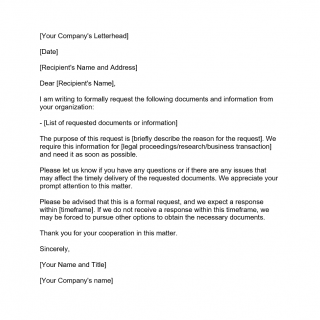Request for Documentation
A Request for Documentation form is a formal request made by an individual or organization to another party to provide specific documents or information. The main purpose of the form is to obtain relevant documents and information necessary for various purposes such as legal proceedings, research, or business transactions.
The form typically consists of a header section that includes the recipient's name and contact information, the requester's name and contact information, and the date of the request. The body of the form includes a description of the requested documents or information, the reason for the request, and any deadlines or other requirements.
Important fields to consider when compiling the form include the specific documents or information being requested, the reason for the request, and any deadlines or other requirements. It's also important to include contact information for the requester and recipient in case there are any questions or issues that need to be addressed.
When compiling a Request for Documentation form, it's important to provide as much detail as possible about the requested documents or information. This may include specific dates, names, or other identifying information that will help the recipient locate the requested information. Depending on the purpose of the request, additional documents may need to be attached, such as a copy of a legal complaint or a research proposal.
Application examples of a Request for Documentation form include requesting medical records for a personal injury lawsuit or requesting financial records for a business transaction. Use cases may include requesting employment records for a background check or requesting academic transcripts for a college application.
Strengths of the form include its formal and organized structure, which can help ensure that all necessary information is included and that the request is taken seriously. Weaknesses may include the potential for delays or complications if the requested information is difficult to locate or if the recipient is unresponsive.
Alternative forms or analogues may include a subpoena, a Freedom of Information Act request, or a discovery request in a legal proceeding. The main difference between these forms and a Request for Documentation form is the legal context in which they are used.
The Request for Documentation form can affect the future of the participants by providing them with access to important information that may be necessary for legal proceedings, research, or business transactions.
The form is typically submitted via mail or email, depending on the recipient's preference. It is important to keep a copy of the form and any attachments for future reference. The form should be stored in a secure location to ensure the confidentiality and protection of the requested information.

